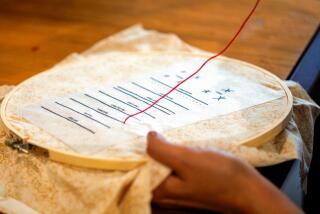AROUND HOME : Seminole Patchwork
- Share via
SEMINOLE PATCHWORK MAY be the only completely modern American Indian art. It was never made by hand: The Seminole and Miccosukee Indians in Florida got their hands on some sewing machines in the 1880s, and in the 1930s and ‘40s the craft reached its creative peak, with Indian women wearing--and selling to tourists--huge full-circle skirts made from thousands of tiny pieces of brightly colored fabrics.
The technique looks awesomely labor-intensive, machine or no machine. All those pieces; all those seams. But there’s a trick, and it’s wonderfully simple. Fabric is cut into long, narrow strips; different-colored strips are sewn together, making a wider, striped strip, which is then cut into small vertical sections. These sections are sewn together at an angle, so that, say, the middle color now touches the lower color. The jagged edges at top and bottom are removed, usually replaced by borders, and there is a brand-new piece of patchwork.
This basic method can yield a huge number of variations; the strips and the vertically cut pieces can be varied in width, and just changing the angles can make a different pattern.
Today’s Seminole patchwork technique is likely to be used to make vests, place mats, clothing (but rarely one of those full-blown, full-circle Indian skirts) and tote bags. Materials used are prints and muted colors and the more traditional brights as well. Whatever its use, Seminole patchwork is appealing: It looks precise, neat and more complicated than it really is.
Classes in Seminole patchwork are sometimes offered at Louise’s Fabrics and Quiltworks in Sherman Oaks; the Quilt Emporium in Calabasas; Quilt’n Things in Montrose; the Piecemaker Country Store in Costa Mesa; Material Pleasures in Arcadia, and the Quilt Inn in Thousand Oaks. Two books on the technique are “The Seminole Patchwork Book,” by Cheryl Greider Bradkin (the most widely available), and “Seminole Patchwork,” by Margaret Brandenbourg.
More to Read
Sign up for The Wild
We’ll help you find the best places to hike, bike and run, as well as the perfect silent spots for meditation and yoga.
You may occasionally receive promotional content from the Los Angeles Times.






